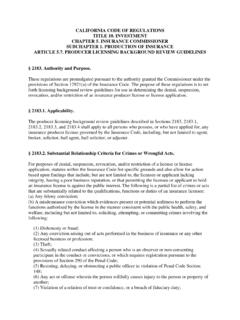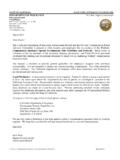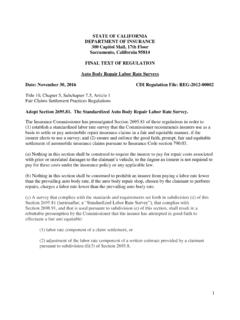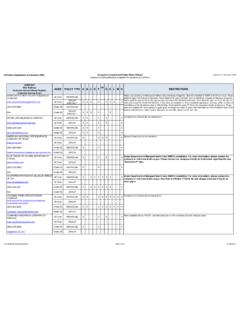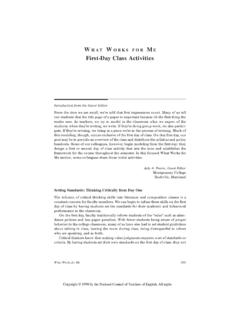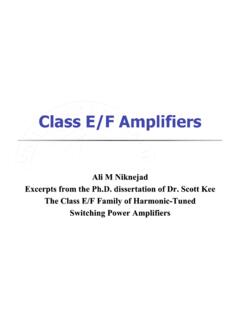Transcription of Class Plan Instructions041511
1 STATE OF CALIFORNIA. DEPARTMENT OF INSURANCE. PRIVATE PASSENGER AUTO Class plan FILING INSTRUCTIONS. Every insurer wishing to introduce a new Private Passenger Automobile program, change an approved Class plan , the values assigned to the rating factors, or any values assigned to the make, model, value, cost of repair or auto symbols for the insured vehicles must complete a Class plan Filing Application in compliance with Title 10, Chapter 5, Subchapter of the California Code of Regulations, Sections through and the California Insurance Code, Sections and.
2 Together with any other detailed supporting statistics and information as the Commissioner may require. Send all Private Passenger Auto Class plan Applications to: CALIFORNIA DEPARTMENT OF INSURANCE. RATE REGULATION BRANCH. Rate Filing Bureau Attn.: Intake Unit 45 Fremont Street, 23rd Floor San Francisco, CA 94105. Important Note: Refer to the CDI website at for the application templates and tables needed to complete this application. The available templates and data for use include: Sequential Analysis Guidelines Frequency and Severity Bands Manual Proxy Weighting Calculation Mileage and/or Years Licensed & Allowable Optional Rating Factor Form CDI 10,000 Vehicle Record Data Set A filing fee is not required with this application.
3 Each insurer will be billed an administrative fee. This application applies only to private passenger auto Class plans. Separate applications apply for Prior Approval Rates, Advisory Organizations, File and Use (Credit and Title), and Workers' Compensation, including Excess Workers Compensation. Filings may be submitted electronically using the NAIC's System for Electronic Rate and Form Filing (SERFF), by CD or by paper. CD's and electronic rate applications must be submitted in Excel and PDF. format. In addition, CDI template(s) must be submitted in excel format.
4 04/15/11 Class plan Filing Instructions Page 1. If either the paper or CD filing method is selected, one (1) original and one (1) copy of the filing and supporting documents must be submitted. Paper and CD filings must contain a self-addressed, stamped envelope for acknowledgement. A copy of application page CP1 and CP2, for group filings, will be sent to the filer as an acknowledgment. Acknowledgment is automatically provided for filings submitted via SERFF. I. GENERAL INFORMATION. A. Application Insurers must submit a Class plan application for new programs, revisions to existing Class plans, adoption of another company's rating plan (me-too) and for introducing or revising auto symbols or vehicle series factors.
5 Each insurer must indicate the type of filing submitted for review and provide the corresponding Class plan application pages plus exhibits according to the requirements shown on application page CP-3. The Department emphasizes that no rate application will be required to accompany the verified actual mileage or specified price per mile Class plans if the Class plans submitted are revenue neutral. Although existing regulation section (c) requires that Class plans be submitted with an accompanying rate filing, that section only applied to applications filed during the two-year transition period for the 2006 amendments to the weight ordering requirements of regulation section (d).
6 For applications submitted by an insurer already in full compliance with the 2006. amendments to regulation section (d), when a Class plan is revenue neutral, an accompanying rate application is not required. However, if during the review process the Department determines that there is a rate impact, an accompanying rate application, or an amended Class plan eliminating the rate impact, will be required before the Class plan is approved. A complete Class plan application which includes a sequential analysis is required when introducing or changing any rating factor specified in CCR Definitions for Rating Factors and Class plan are provided in CCR and and paraphrased below.
7 CCR (a) and (b) provide that: Subsection (a) - The term rating factor is any factor, including discounts, used by an insurer which establishes or affects the rates, premiums, or charges assessed for a policy of automobile insurance. Subsection (b) - The type or limits of coverage or deductibles and auto symbols are not rating factors. In accordance with CCR (a) and (b), the term Class plan means the following: Subsection (a) - The schedule of rating factors and discounts, and their order and manner of analysis as required by Section , in the development of rates and premiums charged for a policy of automobile insurance.
8 04/15/11 Class plan Filing Instructions Page 2. Subsection (b) - In accordance with Section , the analysis or consideration of types or limits of coverage or deductibles, make, model, value, cost of repair, and auto symbols of the insured vehicles. Class plan matters noted within CCR (a) require sequential analysis and factor weights processing while those noted in CCR (b) do not. Examples of changes requiring a Class plan filing are changes in a) the schedule of rating factors, b). rating factor definitions, c) relativities, and d) changes to the existing symbol for a particular automobile.
9 B. Types of Vehicles Requiring a Class plan Each Private Passenger Automobile program requires a separate Class plan filing application. An insurer writing a program for the following types of vehicles, as defined in CIC 660 (a) and must file a Class plan . 1. Motor vehicles of the private passenger or station wagon type that are not used as a public or livery conveyance for passengers, nor rented to others, 2. Other four-wheel motor vehicles with a load capacity of 1,500 pounds or less, (except as permitted by CIC ) or 3. Motorcycles. C. Programs By Coverage Differences Rating tiers are disallowed in private passenger auto.
10 However, more than one program may exist within the private passenger auto line of insurance if such programs differ in rates because of significant and relevant coverage differences; hence, the corresponding cost of that coverage will differ between the programs. If a company has more than one program based on significant and relevant coverage differences, the differing products must be offered to all applicants, with the intention that the applicant may decide among the available program options. The Prior Approval Rate Application must provide a detailed description of the significant and relevant coverage differences by coverage to support the rate differentials between the programs.
